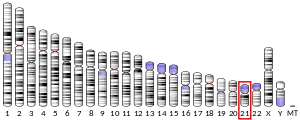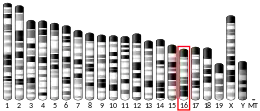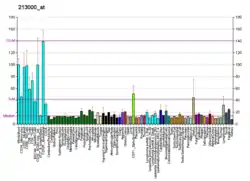| MORC3 | |||||||||||||||||||||||||||||||||||||||||||||||||||
|---|---|---|---|---|---|---|---|---|---|---|---|---|---|---|---|---|---|---|---|---|---|---|---|---|---|---|---|---|---|---|---|---|---|---|---|---|---|---|---|---|---|---|---|---|---|---|---|---|---|---|---|
| |||||||||||||||||||||||||||||||||||||||||||||||||||
| Identifiers | |||||||||||||||||||||||||||||||||||||||||||||||||||
| Aliases | MORC3, NXP2, ZCW5, ZCWCC3, MORC family CW-type zinc finger 3 | ||||||||||||||||||||||||||||||||||||||||||||||||||
| External IDs | OMIM: 610078 MGI: 2136841 HomoloGene: 32257 GeneCards: MORC3 | ||||||||||||||||||||||||||||||||||||||||||||||||||
| |||||||||||||||||||||||||||||||||||||||||||||||||||
| |||||||||||||||||||||||||||||||||||||||||||||||||||
| |||||||||||||||||||||||||||||||||||||||||||||||||||
| |||||||||||||||||||||||||||||||||||||||||||||||||||
| |||||||||||||||||||||||||||||||||||||||||||||||||||
| Wikidata | |||||||||||||||||||||||||||||||||||||||||||||||||||
| |||||||||||||||||||||||||||||||||||||||||||||||||||
MORC family CW-type zinc finger protein 3 is a protein that in humans is encoded by the MORC3 gene.[5][6]
This gene encodes a protein that localizes to the nuclear matrix. The protein also has RNA binding activity, and has a predicted coiled-coil domain.[6]
See also
References
- 1 2 3 GRCh38: Ensembl release 89: ENSG00000159256 - Ensembl, May 2017
- 1 2 3 GRCm38: Ensembl release 89: ENSMUSG00000039456 - Ensembl, May 2017
- ↑ "Human PubMed Reference:". National Center for Biotechnology Information, U.S. National Library of Medicine.
- ↑ "Mouse PubMed Reference:". National Center for Biotechnology Information, U.S. National Library of Medicine.
- ↑ Perry J, Zhao Y (Nov 2003). "The CW domain, a structural module shared amongst vertebrates, vertebrate-infecting parasites and higher plants". Trends Biochem Sci. 28 (11): 576–80. doi:10.1016/j.tibs.2003.09.007. PMID 14607086.
- 1 2 "Entrez Gene: MORC3 MORC family CW-type zinc finger 3".
Further reading
- Nagase T, Seki N, Tanaka A, et al. (1996). "Prediction of the coding sequences of unidentified human genes. IV. The coding sequences of 40 new genes (KIAA0121-KIAA0160) deduced by analysis of cDNA clones from human cell line KG-1". DNA Res. 2 (4): 167–74, 199–210. doi:10.1093/dnares/2.4.167. PMID 8590280.
- Bonaldo MF, Lennon G, Soares MB (1997). "Normalization and subtraction: two approaches to facilitate gene discovery". Genome Res. 6 (9): 791–806. doi:10.1101/gr.6.9.791. PMID 8889548.
- Hattori M, Fujiyama A, Taylor TD, et al. (2000). "The DNA sequence of human chromosome 21". Nature. 405 (6784): 311–9. Bibcode:2000Natur.405..311H. doi:10.1038/35012518. PMID 10830953.
- Kimura Y, Sakai F, Nakano O, et al. (2002). "The newly identified human nuclear protein NXP-2 possesses three distinct domains, the nuclear matrix-binding, RNA-binding, and coiled-coil domains". J. Biol. Chem. 277 (23): 20611–7. doi:10.1074/jbc.M201440200. PMID 11927593.
- Strausberg RL, Feingold EA, Grouse LH, et al. (2003). "Generation and initial analysis of more than 15,000 full-length human and mouse cDNA sequences". Proc. Natl. Acad. Sci. U.S.A. 99 (26): 16899–903. Bibcode:2002PNAS...9916899M. doi:10.1073/pnas.242603899. PMC 139241. PMID 12477932.
- Ota T, Suzuki Y, Nishikawa T, et al. (2004). "Complete sequencing and characterization of 21,243 full-length human cDNAs". Nat. Genet. 36 (1): 40–5. doi:10.1038/ng1285. PMID 14702039.
- Rosendorff A, Sakakibara S, Lu S, et al. (2006). "NXP-2 association with SUMO-2 depends on lysines required for transcriptional repression". Proc. Natl. Acad. Sci. U.S.A. 103 (14): 5308–13. Bibcode:2006PNAS..103.5308R. doi:10.1073/pnas.0601066103. PMC 1459351. PMID 16567619.
- Takahashi K, Yoshida N, Murakami N, et al. (2007). "Dynamic regulation of p53 subnuclear localization and senescence by MORC3". Mol. Biol. Cell. 18 (5): 1701–9. doi:10.1091/mbc.E06-08-0747. PMC 1855011. PMID 17332504.
This article is issued from Wikipedia. The text is licensed under Creative Commons - Attribution - Sharealike. Additional terms may apply for the media files.




